 |
 |
 |
| |
The Effect of Vicriviroc Upon Viral Load in HIV/HCV Co-infected Patients Receiving a Ritonavir-containing Protease Inhibitor Regimen
|
| |
| |
Reported by Jules Levin
CROI 2008, Boston
G. Fatkenheuer1, C. Hoffmann2, J. Slim3, R. Rouzier4, A. Keung5, J. Li5, M. Treitel5, A. Sansone-Parsons5, C. Kasserra5, E. O'Mara5, D. Schurmann6
1Univ. Cologne, Cologne, Germany; 2Univ. Kiel, Kiel, Germany; 3Saint Michael's Medical Center, Newark, NJ, USA; 4Centre-CAP, Montpelleir, France;
5Schering-Plough Research Institute, Kenilworth, NJ, USA; 6Charite-Universitatsmedizin, Berlin, Germany
Conclusions
· VCV, administered in a RTV-containing PI-based regimen to HIV/HCV coinfected patients, did not result in any clinically meaningful changes to HCV RNA viral load.
· HCV co-infection did not adversely impact HIV-1 RNA virologic suppression in patients treated with VCV and an RTV-containing PI-based regimen.
· In this pilot study of HIV/HCV coinfected patients receiving VCV 5, 10 or 15 mg with a RTV-containing PI-based regimen, there were no clinically relevant declines in CD4+ cell counts.
· The rate and severity of AEs associated with VCV administration were similar to those observed in the placebo group.
· VCV, when co-administered with a RTV-containing PI-based regimen to HIV/HCV co-infected patients, does not require dose adjustment.
· Treatment with VCV as part of a RTV-containing PI-based regimen was safe and well tolerated in an HIV/HCV coinfected population.
· The VCV (30 mg, QD) phase 3 program in HIV mono-infected and HIV/HCV co-infected, HAART-experienced patients is ongoing, supported by the data from this study.
Abstract Results
Background: Inhibition of HIV entry by CCR5 antagonists is a new strategy currently being studied for treatment of HIV infection. As CCR5 co-receptors are present on a variety of other immune cells (e.g. CD8+ cells), the effect of CCR5 inhibition on the HCV viral load of patients co-infected with HIV/HCV was studied.
Methods: Co-infected patients, whose HIV was stable (<400c/mL) on ritonavir-containing protease inhibitor (PI) antiretroviral therapy were enrolled into this randomized, double-blind, placebo controlled, multicenter study. Forty subjects were scheduled to receive 5 mg, 10 mg, 15 mg vicriviroc (VCV) qd, or placebo for 28 days in addition to their stable background therapy. Safety was the primary objective of this study, and pharmacokinetics (PK) was a secondary objective. Clinical examination and laboratory tests (e.g. HCV RNA, ALT, AST, GGT) were conducted throughout the study. An intention to treat analysis was performed, including all randomized subjects with HCV RNA at all time points as the primary parameter.
Results: The study was closed after enrollment of 28 subjects (18 men, 10 women). Baseline characteristics were: median 41 (25-54) years of age, 86% (24) Caucasian and median CD4+ cell count 436 (128-1240)/mL. No substantive changes in HCV RNA were noted between baseline, timepoints associated with VCV or placebo administration, and follow-up (Figure 1). Adverse events were equally distributed among placebo and VCV arms and were generally mild (headache, diarrhea). Transient elevations of ALT, AST, or GGT occurred in 4 patients on treatment (3 VCV, 1 placebo), 2 of which were considered clinically meaningful (1 VCV 10 mg, 1 placebo). PK parameters (Cmax, Cmin, AUC) of VCV were dose-dependent and comparable to healthy volunteers.
Discussion: This was the first study of a CCR5 antagonist in patients with HIV and HCV co-infection. No clinically meaningful changes in HCV viral load were observed in stable co-infected patients receiving VCV in combination with a RTV-containing PI regimen. Vicriviroc in combination with background therapy was safe and well tolerated when administered for 28 days.
INTRODUCTION
Mechanism of Action
· VCV is a next-generation extracellular inhibitor of HIV infection designed to block entry of infectious virions into uninfected CD4+ T-lymphocytes via antagonism of the CCR5 co-receptor (CCR5 antagonist).1
Biology
· The normal function of the CCR5 receptor in the cell membrane is to cause, upon ligand binding, chemotaxis of that cell to areas of inflammation and infection.2
· Because CCR5 receptors are present on cells other than CD4+ cells, such
as CD8+ T-lymphocytes and macrophages, there is a theoretical potential
for a CCR5 receptor antagonist to impede the chemotaxis of CD8+ T-lymphocytes to the liver in HIV+ patients co-infected with hepatitis C virus
(HCV).3 CD8+ T-lymphocytes have the role of eliminating HCV-infected cells.
Clinical Experience
· HCV co-infection is found in ~30% of the total HIV-infected population and in 60%-90% of HIV-infected intravenous drug users. Co-infection negatively affects survival in these patients.4
· Vicriviroc (VCV) is in Phase 3 development (30 mg, QD) for the treatment of HAART-experienced HIV-1 infected patients receiving a protease inhibitor (PI)-based regimen that includes ritonavir (RTV).5
Pharmacokinetics
· VCV plasma concentrations are increased 2-6 fold by potent CYP3A inhibitors, including ritonavir.6
· VCV plasma half-life of >24 hours allows for once-daily dosing.7
Methods
STUDY DESIGN
Objectives
· Primary: To evaluate the safety of administering VCV to HIV/HCV co-infected patients on an established, fully suppressive RTV-containing protease inhibitor regimen by monitoring changes in HCV viral load and safety parameters
· Secondary: To assess measures of immune function and determine the pharmacokinetic profile of VCV in HIV/HCV co-infected patients who are on an established RTV-containing PI-based regimen
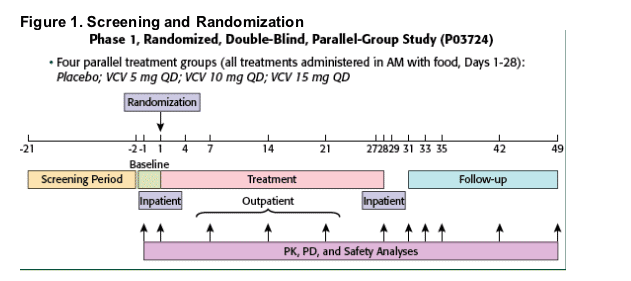
Assessments
· HCV RNA evaluated in all patients at each sampling time (LLD <50 IU/mL)
· Pharmacodynamics (starting at baseline, Day -1)
- Changes in HCV RNA and HIV-1 RNA in all patients at each sampling time
- CD4+ cell counts on Days -1, 14, 28, and 42
· Pharmacokinetic parameters of VCV evaluated on Days 1 and 28
- Cmax, AUC, Tmax, Cmin, R (accumulation ratio), CL/F (apparent total body clearance), and Vd/F (apparent volume of distribution)
· Samples collected on Days 31, 33, 35, 42, and 49 were used to measure laboratory parameters after cessation of VCV treatment but continued RTV treatment
INCLUSION/EXCLUSION CRITERIA
Selected Inclusion Criteria
· Male or nonpregnant female HIV+ patients, 18-55 years of age
· Patients on an established RTV-containing PI-based regimen for at least 4 weeks prior to administration of study drug, with a viral load <400 copies/mL
· Co-infected with HCV (detectable HCV RNA, any genotype)
· Must have compensated liver disease
· Clinical laboratory tests (CBC, blood chemistry, and urinalysis) must be within normal limits for this population or deviations must be considered not clinically meaningful
- CD4+ counts >200/mL
- Platelets > 120,000/mL
- Albumin within normal limits
- ALT and AST 5 ' ULN (CTC Grade 2 or less)
· ECG results within normal limits
Selected Exclusion Criteria
· Participation in a clinical trial of an investigational drug within 90 days prior to the start of the study, or having received prior treatment with a CCR5 receptor antagonist
· Positive for hepatitis B surface antigen
· A history of any serious local or systemic infectious disease, other than HIV and HCV, within 4 weeks prior to study enrollment
· Ascites, bleeding varices, or spontaneous encephalopathy
· A history of seizures or having suffered head trauma with loss of consciousness
· History of any major food or drug allergy or allergy to any component of VCV
· Unwilling to use/practice an effective method of contraception as defined in the protocol
· Positive drug screen
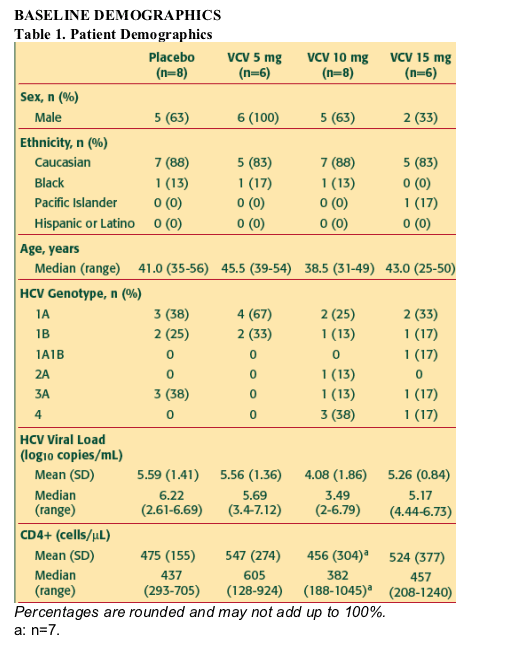
· 28 out of a planned 40 patients were enrolled and randomized; all completed the study.
- The study was terminated prematurely due to slow recruitment of patients.
- The majority of patients were taking Kaletra (lopinavir/RTV) as their RTV-containing PI regimen.
· Although not excluded by the study protocol criteria, no patients were being actively treated for chronic HCV (PEG-interferon/ribavirin) during the course
of the study.
CHANGES IN HCV RNA
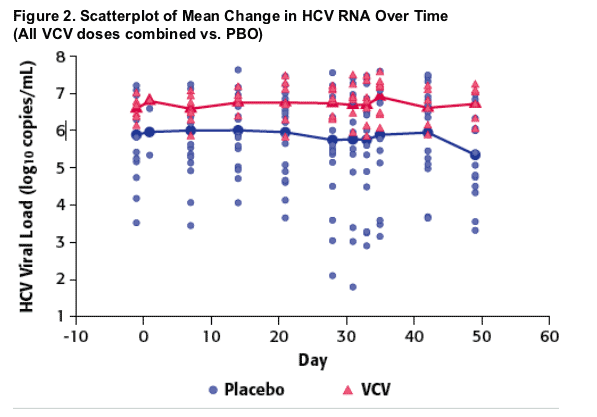
· Plasma HCV RNA did not change to a clinically meaningful extent in any group (VCV or placebo).
· Median change in plasma HCV RNA at end of treatment, Day 28:
- Placebo (n=8): +0.75 log10 copies/mL
- Combined vicriviroc arms (n=20): +0.18 log10 copies/mL
· VCV 5 mg (n=6): +0.36 log10 copies/mL
· VCV 10 mg (n= 8): +0.41 log10 copies/mL
· VCV 15 mg (n=6): -0.31 log10 copies/mL
· Two subjects exhibited increases in HCV RNA 33 log10 copies/mL.
- One was receiving placebo, and the other received VCV 10 mg.
- There were no concomitant increases in ALT observed in these 2 subjects.
CHANGES IN HIV-1 RNA
· All patients had HIV viral loads <400 copies/mL at baseline and remained virologically suppressed throughout the study, except for 3 patients who exhibited a single HIV-1 RNA increase >400 copies/mL on a single occasion (VCV 5 mg, n=2 and VCV 10 mg, n=1).
- Two patients receiving VCV 5 mg exhibited Day 14 viral loads of 739 and 2,300 copies/mL
- One patient receiving VCV 10 mg exhibited a Day 28 viral load of 539 copies/mL
- In all three cases, viral load had returned to <400 copies/mL by the next evaluation
CHANGES IN CD4+ COUNTS
· There were no clinically concerning changes in total lymphocytes, CD4+, CD8+ or CD39+ cell counts.
· Median baseline and change in CD4+ cell counts (cells/mm3) at end of treatment, Day 28:
- Placebo (n=8): Baseline: 436.5, Change: +57.0
- Combined VCV arms (n=20): Baseline: 506.2, Change: +142.0
· VCV 5 mg (n=6): Baseline: 604.5, Change: +125.3
· VCV 10 mg (n= 8): Baseline: 382.2, Change: +17.5
· VCV 15 mg (n=6): Baseline: 457.2, Change: +97.9
VCV Pharmacokinetics
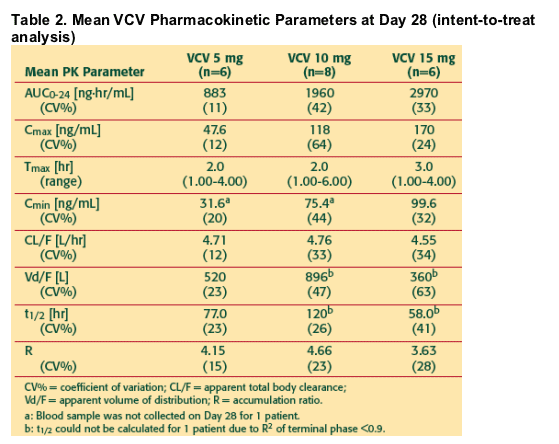
· Cmax, Cmin, and AUC increased with dose from 5 mg to 15 mg
· Steady-state was attained by Day 14 in all treatment groups
Laboratory Tests
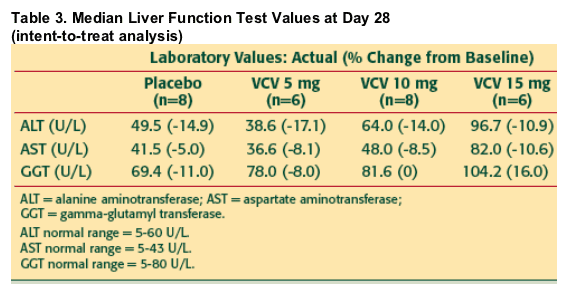
· There were no clinically meaningful changes in blood chemistry and hematology parameters, including sodium, potassium, chloride, blood urea, creatinine, glucose, bilirubin, and cholesterol
· Greater than two-fold elevations in ALT, AST and/or GGT occurred in 2 patients receiving VCV
- One patient in the VCV 5 mg group had transient elevations (AST 172 U/L, ALT 392 U/L) on Day 14 that resolved by Day 28
- One patient in the VCV 10 mg group had high AST (102 U/L), ALT (187 U/L), and GGT (144 U/L) at baseline that increased considerably by Day 28 (AST 186, ALT 376, and GGT 218 U/L, respectively). These levels remained high through follow-up, with the highest values at the last visit (AST 216, ALT 398, and GGT 235 U/L at 37 days after the last dose of study drug)
· Two patients (1 in VCV 15 mg group and 1 in the placebo group) had lesser increases in AST and/or ALT that were transient and reversible
· All patients remained asymptomatic
ADVERSE EVENTS
· The number of treatment-emergent AEs was similar between placebo and the VCV treatment arms
· The most common treatment-related AEs were gastrointestinal; these were mild in severity
· There was no dose-related increase in AEs and no trends were noted
- Four subjects in the placebo group experienced moderate AEs (peritonsillar abscess, ALT increase, headache and pharyngolaryngeal pain)
- No subjects in the VCV 5 mg group experienced moderate or severe AEs
- Two subjects in the VCV 10 mg group experienced moderate to severe AEs (gastrointestinal disorder, asthenia, ALT or GGT increase, headache, cough, and circulatory collapse)
- Three subjects in the VCV 15 mg group experienced moderate AEs (fatigue,
nasopharyngitis, periodontal infection, migraine, CD4+ cell decrease)
Conclusions
· VCV, administered in a RTV-containing PI-based regimen to HIV/HCV coinfected patients, did not result in any clinically meaningful changes to HCV RNA viral load.
· HCV co-infection did not adversely impact HIV-1 RNA virologic suppression in patients treated with VCV and an RTV-containing PI-based regimen.
· In this pilot study of HIV/HCV coinfected patients receiving VCV 5, 10 or 15 mg with a RTV-containing PI-based regimen, there were no clinically relevant declines in CD4+ cell counts.
· The rate and severity of AEs associated with VCV administration were similar to those observed in the placebo group.
· VCV, when co-administered with a RTV-containing PI-based regimen to HIV/HCV co-infected patients, does not require dose adjustment.
· Treatment with VCV as part of a RTV-containing PI-based regimen was safe and well tolerated in an HIV/HCV coinfected population.
· The VCV (30 mg, QD) phase 3 program in HIV mono-infected and HIV/HCV co-infected, HAART-experienced patients is ongoing, supported by the data from this study.
REFERENCES
1. Strizki JM, Tremblay C, Xu S, et al. Discovery and characterization of vicriviroc (SCH 417690), a CCR5 antagonist with potent activity against human immunodeficiency virus type 1. Antimicrob Agents Chemother. 2005;49:4911-4919.
2. Shields PL, Morland CM, Salmon M, et al. Chemokine and chemokine receptor interactions provide a mechanism for selective T cell recruitment to specific liver compartments within hepatitis C-infected liver. J Immunol. 1999;163:6236-6243.
3. Fukada K, Sobao Y, Tomiyama H, et al. Functional expression of the chemokine receptor CCR5 on virus epitope-specific memory and effector CD8+ T cells. J Immunol. 2002;168:2225-2232.
4. Tedaldi EM, Baker RK, Moorman AC, et al. Influence of coinfection with hepatitis C virus on morbidity and mortality due to human immunodeficiency virus infection in the era of highly active antiretroviral therapy. Clin Infect Dis. 2003;36:363-367.
5. Data on file. Schering Corporation; Kenilworth, NJ.
6. Sansone A, Keung A, Tetteh E, et al. Pharmacokinetics of vicriviroc are not affected in combination with five different protease inhibitors boosted by ritonavir [abstract 582]. In: Program and abstracts of the 13th Conference on Retroviruses and Opportunistic Infections, Denver, CO, February 5-8, 2006.
7. Seiberling M, Kraan M, Keung A, Martinho M, Sansone A. Similar increase in SCH 417690 plasma exposure with coadministration of varying doses of ritonavir in healthy volunteers. In: Program and abstracts of the 6th International Workshop on Clinical Pharmacology of HIV Therapy, Quebec City, Que., Canada, April 28-30, 2005.
8. Saltzman M, Rosenberg M, Kraan M. Pharmacokinetics of vicriviroc administered alone or in combination with ritonavir and efavirenz in healthy volunteers [abstract TuPe3.1B08]. In: Program and abstracts of the 3rd IAS Conference on HIV Pathogenesis and Treatment, Rio de Janiero, Brazil, July 24-27, 2005.
9. Sansone-Parsons A, Keung A, Caceres M, et al. Renal insufficiency has no clinically significant impact on pharmacokinetics of vicriviroc administered alone or in the presence of a potent CYP3A4 inhibitor [abstract 57]. In: Program and abstracts of the 8th International Workshop on Clinical Pharmacology of HIV Therapy, Budapest, Hungary, April 16-18, 2007.
|
| |
|
 |
 |
|
|